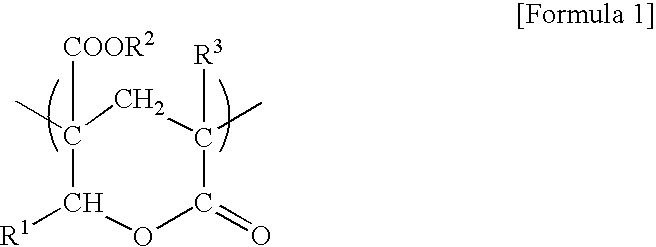Pressure-sensitive adhesive composition for optical film, pressure-sensitive adhesive layer for optical film, production method thereof, pressure-sensitive adhesive optical film and image display
a technology of pressure-sensitive adhesive and composition, which is applied in the direction of film/foil adhesive, instrument, synthetic resin layered products, etc., can solve the problems of long time required until shipment, difficult to subject optical films from thin liquid crystal panels to reworking or working processes, and difficult to form pressure-sensitive adhesive layers. , to achieve the effect of improving processability and reworkability, easy peeling, and effective recycling of liquid crystal panels
- Summary
- Abstract
- Description
- Claims
- Application Information
AI Technical Summary
Benefits of technology
Problems solved by technology
Method used
Image
Examples
production example 1
[0177]To a four-neck flask equipped with a stirring blade, a thermometer, a nitrogen gas introducing tube and a condenser were added 99.7 parts of butyl acrylate, 0.1 parts of N,N-dimethylaminoethyl acrylate, 0.1 parts of acrylic acid, 0.1 parts of 4-hydroxybutyl acrylate, 0.1 parts of 2,2′-azobisisobutyronitrile as a polymerization initiator, and 200 parts of ethyl acetate. Nitrogen gas was introduced to replace the air, while the mixture was gently stirred, and then a polymerization reaction was performed for 6 hours, while the temperature of the liquid in the flask was kept at about 60° C., so that a solution of an acrylic polymer was prepared. The acrylic polymer had a weight average molecular weight of 2,050,000.
production examples 2 to 14
and Comparative Production Examples 1 to 7
[0178]Acrylic polymer solutions were prepared using the process of Production Example 1, except that at least one of the type and amount of the monomer components was changed as shown in Table 2 and that toluene was used as the solvent in place of ethyl acetate in Production Example 14. The weight average molecular weight of the acrylic polymer obtained in each example is shown in Table 2.
example 1
(Production of Pressure-Sensitive Adhesive Layer-Carrying Polarizing Plate)
[0179]Based on 100 parts of the solids of the acrylic polymer solution obtained in Production Example 1, 0.3 parts of substituted benzoyl peroxide (NYPER BMT40 manufactured by NOF CORPORATION) serving as a crosslinking agent, 0.2 parts of trimethylolpropane-tolylene diisocyanate (Coronate L manufactured by Nippon Polyurethane Industry Co., Ltd.) also serving as a crosslinking agent, and 0.1 parts of a silane coupling agent (KBM573 manufactured by Shin-Etsu Chemical Co., Ltd.) were added to the acrylic polymer solution so that an acrylic pressure-sensitive adhesive solution was prepared.
[0180]The acrylic pressure-sensitive adhesive solution was then applied to one side of a silicone-treated polyethylene terephthalate (PET) film (MRF38 manufactured by Mitsubishi Polyester Film Corp.) serving as a separator such that the pressure-sensitive adhesive layer would have a thickness of 20 μm after drying. The acrylic ...
PUM
| Property | Measurement | Unit |
|---|---|---|
| temperature | aaaaa | aaaaa |
| temperature | aaaaa | aaaaa |
| one-minute half-life temperature | aaaaa | aaaaa |
Abstract
Description
Claims
Application Information
 Login to View More
Login to View More - R&D
- Intellectual Property
- Life Sciences
- Materials
- Tech Scout
- Unparalleled Data Quality
- Higher Quality Content
- 60% Fewer Hallucinations
Browse by: Latest US Patents, China's latest patents, Technical Efficacy Thesaurus, Application Domain, Technology Topic, Popular Technical Reports.
© 2025 PatSnap. All rights reserved.Legal|Privacy policy|Modern Slavery Act Transparency Statement|Sitemap|About US| Contact US: help@patsnap.com

